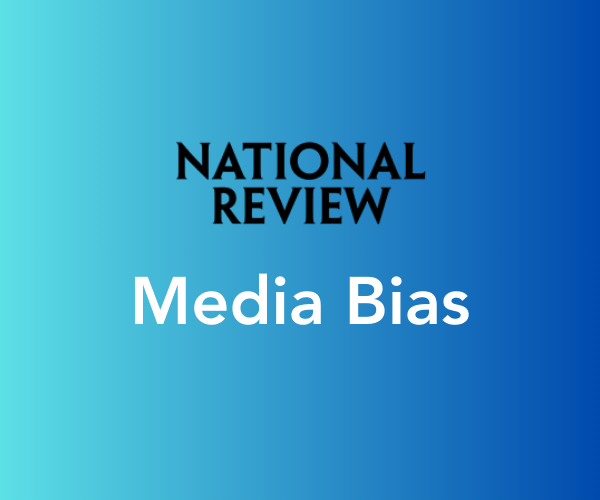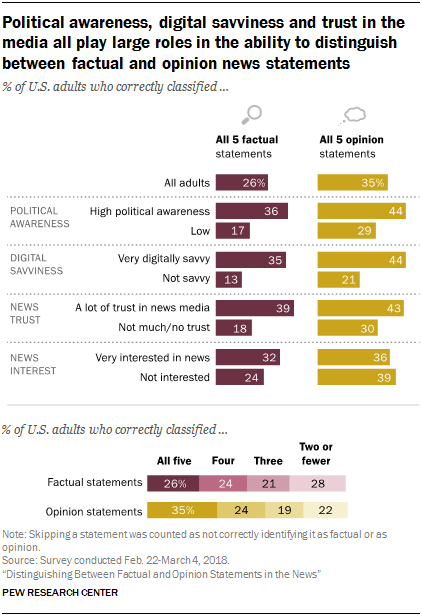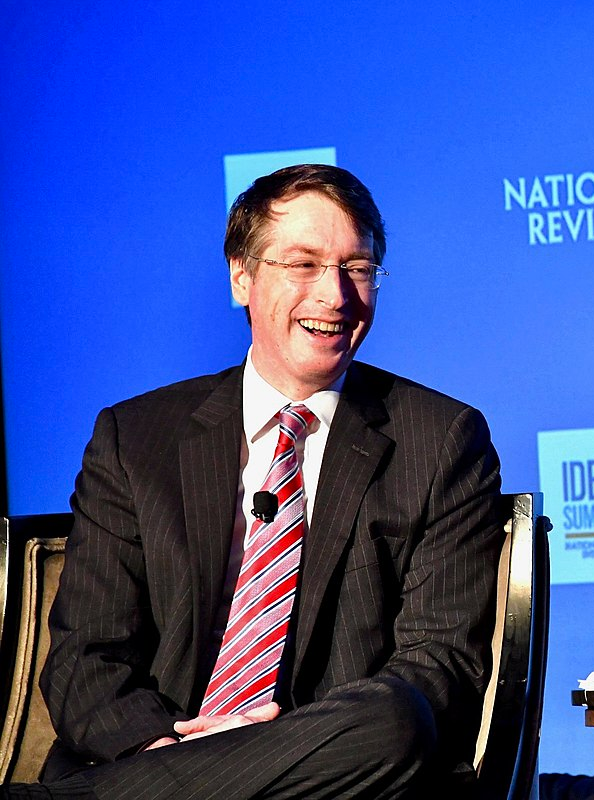
Since its establishment in 1955, The National Review has risen as one of the most prominent conservative editorial magazines in the United States. Headquartered in New York City, New York, this influential media outlet has consistently championed right-wing policies, ideas, and principles. In 2022, The National Review accumulated over 1.4 million social media followers and 25 million monthly page views.
Though a popular digital and print newspaper with a reputation for delivering high-quality conservative journalism, The National Review’s alleged bias requires further exploration. This article thoroughly investigates their coverage and editorial decisions to determine discernible political preferences in their reporting. Through this comprehensive analysis, we seek to provide a clear answer to just how conservatively driven The National Review is, shedding light on the various factors that contribute to media bias in general.
How Does Biasly Rate News Sources?
Biasly’s algorithms produce bias ratings to help provide multiple perspectives on given articles. Biasly has analyzed 200,000+ news articles from more than 3,200 news sources through our A.I. technology and team of political analysts to find the most factual, unbiased news stories.
Biasly determines the degree of political bias in news sources by using Biasly’s Bias Meter Rating, in which Biasly’s team analyzes media sources’ reliability and bias and produces three scores, a Reliability Score that measures the accuracy of media sources; an A.I. Bias Score, evaluated by A.I.; and an Analyst Bias Score evaluated by political analysts. These scores are rated based on seven rating metrics including Tone, Tendency, Diction, Author Check, Selection/Omission, Expediency Bias, and Accuracy. These metrics help our analysts to determine the political attitude of the article.
Our A.I. machine-learning system employs natural language processing and entity-specific sentiment analysis to examine individual articles and determine their bias levels. By analyzing the key terms in an article such as policies, bias phrases, political terminologies, politicians, and their nicknames, the algorithms can rate the attitude of the text. Bias scores range from -100% and 100%, with higher negative scores being more liberal and higher positive scores being more conservative, and 0% being neutral.
Is The National Review Politically Biased?
Biasly’s ratings derive from two sources: one from its A.I.-driven computer algorithms and the other from its analysts. Ratings for The National Review display a Computer bias score of Very Conservative and an Analyst bias score of Somewhat Conservative. The publication’s apparent praise for Republican policies and politicians, along with its noticeable disapproval of Democrats and their competing ideologies, significantly impacts the right-leaning score.
Biasly derives Analyst ratings from an average of 15 articles. An analyst from liberal, moderate, and conservative backgrounds reviews each article. The more pieces the Biasly team assesses for a specific source, the more accurate the rating becomes. The ratings increase in accuracy as Biasly evaluates more articles. Positive views on specific leaders and strategies and critiques of conflicting ideologies and personalities shape these ratings. Often, Biasly’s ratings align with results from other independent bias research entities.
Readers like you are more likely to have a strong opinion of The National Review based on your political leaning. They tend to favor conservative causes and people, as represented by Biasly’s “Very Conservative” score. In the remainder of this article, we’ll discuss ways to identify this bias so you can separate the opinions from the facts and become a more informed citizen.
Before we begin, we need to discuss bias. Bias is a natural function of humans, and we can express it both consciously and unconsciously. Bias is one of the most fundamental forms of pattern recognition in humans. This isn’t to lower the bar and say that “all things are biased,” but to explain the process in which we may come to trust certain news organizations that display patterns of coverage.
On the media’s part, there is an incentive to retain audiences, encourage them to purchase subscriptions, and rate products positively. Bias is a two-way street; people want to see news stories about things they care about, and the media needs viewers to continue their operations. This creates a positive feedback loop that influences what stories are covered and from what perspective.
Analysis of Bias in National Review Online Articles
This analysis will examine several metrics commonly used to measure bias in writing: Tone, Tendency, Author, Diction, and Expediency Bias.
The tone is the emotional core of the writing. At the same time, the diction refers to specific strong word choices by the author—moreover, the author metric orients itself around the writer’s previous works and their expressions of political ideology. Meanwhile, the tendency score measures how often and frequently an article takes a biased stance. The score will increase if one viewpoint is present throughout the author’s work, with multiple examples, arguments, or supporting evidence to back it up. Finally, expediency bias aims to capture emotional responses from the first impression of an article’s headline, image, and summary that a reader sees.
Caroline Downey’s article, “Florida Governor DeSantis Signs Parental Rights in Education Bill,” presents several indicators of the author’s underlying bias. This sentiment is further supported by Biasly, with its news aggregator granting the article a Somewhat Conservative rating of 12% and a Policy leaning score of 22%, which also lies in the same Somewhat Conservative range.
From the beginning, Downey’s choice of phrasing hints at her unique political perspective. The article’s introduction employs the term “backlash” — a word with innately negative connotations — which sets the tone for the opposition to the bill as potentially reactionary or excessive. This choice suggests that ideology, rather than objective or merit-based reasoning, drives the resistance to the account.
“After weeks of progressive backlash and corporate protest from the Walt Disney Company…”
In another segment, Downey aims to correct or clarify what she perceives to be a common misconception about the “Don’t Say Gay” bill:
“Contrary to its misleading nickname, the bill does not outlaw teachers, administrators, or students from using that word.”
By asserting that the bill has a “misleading nickname,” Downey takes a defensive stance, suggesting that critics or the public might not fully understand the bill’s purpose.
Furthermore, she provides a counter-narrative to the primary criticisms of the bill:
“Rather than a bigoted effort to ostracize LGBTQ students and faculty, the bill is explicit that it is designed to keep curriculum about sexuality out of kindergarten through third-grade classrooms.”
Downey juxtaposes “bigoted effort” with the bill’s intent, subtly insinuating that critics might be blowing the legislation out of proportion.
When it comes to representing Governor DeSantis’s perspective, Downey strategically amplifies his voice, emphasizing a narrative that highlights the tension between state policies and corporate views:
“Florida’s policies must be based on the best interest of Florida citizens, not on the musings of woke corporations.”
By using the term “woke corporations,” this quote further reinforces the conservative bias by casting entities like Disney in a dismissive or derogatory light.
In summary, Downey’s article contains distinct undertones that suggest a defense of the bill and Governor DeSantis’s stance. Her choice of phrases, narrative framing, and selected quotations all converge to paint a more skeptical picture of the bill’s critics and lend weight to the article’s conservative bias, as determined by Biasly.
Although Biasly labels The National Review as Very Conservative, partisanship will vary across articles. Therefore, it would be unfair to neglect the minority pieces that fall on the opposing end of the political spectrum. Case in point, specific authors affiliated with The National Review, like Ed Barchrach and Austin Berg, wrote an article entitled “Why Chicago Can’t Get a Grip on Its Murder Crisis,” which Biasly classifies as -10% Liberal.
It covers the rising murder rates in Chicago and how the killings intertwine with a complex intersection of politics, public safety, and police oversight. It also addresses structural issues, systemic challenges, and the need for reform, often aligning with left or center-left policy leanings.
While the article does highlight problems often associated with liberal agendas (such as addressing racial inequalities, rebuilding trust in communities, and reforming police practices), it also critiques the political theater and the potential misgovernance of the current system. This kind of critique could be aligned with a conservative viewpoint, especially when it questions the efficacy of multiple oversight bodies or points to political maneuvers rather than genuine leadership.
Here is a table summarizing specific quotes found in the article and the policy leanings they seem to suggest:
Quote | Bias Leaning | Author Bias |
| “Some reasons for the spike will be familiar to residents of other big cities that have recently experienced a violent-crime surge. These include the isolation and economic carnage of the COVID-19 pandemic, alienated young people, and demoralized police. Some point to root causes such as generational poverty and discrimination against communities of color.” | Liberal | The statement “Some point to root causes such as generational poverty and discrimination against communities of color” can be interpreted as liberal-leaning because it emphasizes structural and systemic issues, like poverty and discrimination, as primary drivers of crime. |
| “No, the problem is profound misgovernance — a system that incentivizes the politicization of policing, rather than professional management.” | Centrist | This statement could be neutral or centrist, as both sides typically agree on avoiding politicized policing and the need for professionalism. However, liberals and conservatives may differ on how to undertake these initiatives, considering the latter tends to be against police reform.
|
| “Some of the changes are shockingly basic — reforms such as maintaining records of officer-performance reviews and creating a process to evaluate whether officer training is effective. But the department has continuously failed to meet even the simplest of its obligations under the consent decree.” | Liberal | This passage delves into the repercussions of Laquan McDonald’s murder, highlighting the tepid execution of “shockingly basic” reforms by the Chicago Police Department. The narrative implies a notable absence of commitment or efficiency, even in instituting the most rudimentary progressive measures. |
Source: The National Review
Considering all this, The National Review is a publication that may sometimes feature perspectives from more left-leaning and center voices.
For instance, this article by Brittany Bernstein, “Trump Pleads Not Guilty to All Four Counts in January 6 Case,” aims to provide a factual report on Trump’s legal proceedings concerning his plea of not guilty to federal charges tied to the January 6 riots.
Tone:
Overall, we can characterize the tone of the article as primarily neutral or centrist, as it mostly refrains from introducing personal emotions or subjective feelings:
“Former president Donald Trump on Thursday pleaded not guilty to four federal charges related to his attempts to overturn the 2020 election.”
This sentence is a prime example, offering a straightforward recounting of events without an emotional undertone.
Diction:
Most of the article’s word choices are neutral. However, there are instances where the word choice could imply a stronger sentiment:
“…the Defendant spread lies…”
The term “lies” is potent and could be viewed as indicative of a bias. Nevertheless, it’s important to note that this is language from the charge itself, not the author’s words.
Author:
Regarding her social media activity, Brittany Bernstein’s Twitter account does not exemplify any overt bias. The posts that do not revolve around her personal life and explicitly discuss politics tend to adopt a neutral or centrist tone.
Still, in 2021, she did retweet a post that Chuck Schumer made on April 20, which is a day that traditionally celebrates cannabis culture. This point is relevant because, in the tweet, Schumer’s face is photoshopped crudely onto a screenshot from the movie Mean Girls. The post parodies a scene where one of the characters says, “I’m not a regular mom, I’m a cool mom.” However, the word “mom” was blacked out and changed to “senator,” recognizing Schumer’s pro-marijuana stance. Below the picture, Schumer wrote a caption saying:
“Happy 420. From the Senate Majority Leader.”
https://t.co/ud2kgX0nvt pic.twitter.com/mx3Z8Mwyn5
— Brittany Bernstein (@brittybernstein) April 21, 2021
Bernstein does not comment on this post, so it is difficult to determine if she exudes a liberal or conservative bias by retweeting it. The answer depends on whether she intended her followers to laugh with or at Schumer. If it was with him, then Bernstein could be signifying more of a liberal bias in favor of marijuana legalization.
However, it is also possible that she retweeted the post from a right-wing standpoint, mocking Schumer and how his sense of humor advocates for cannabis consumption, a policy that left-wingers are usually for and right-wingers are traditionally against.
Tendency:
The article’s tone anchors itself in direct quotations and meticulously recounts events as they occurred. Bernstein consistently emphasizes the charges against Trump, the potential repercussions, and the alleged infractions detailed in the indictment. Barr’s remarks, especially given his former role as Trump’s attorney general, accentuate a discernibly negative tone toward the former President.
“As the indictment says, they are not attacking his First Amendment right…But that does not protect you from entering into a conspiracy.”
Quoting Bill Barr provides an external viewpoint without making it the central narrative of the article. Nevertheless, despite the piece presenting undiluted facts and Bernstein not laying out her exact opinion on the matter, there is a subtle but consistent tone leaning against Trump. This tendency of tone is pervasive throughout the piece, focusing on the gravity of the charges and alleged wrongdoings of the former President rather than a balanced presentation of the situation or potential defenses.
Expediency Bias:

Source: The National Review
With this headline, the article adopts a direct approach, keeping readers informed without employing sensationalism.
Analysis of National Review Opinion Articles
Writers use opinion pieces to express subjective beliefs, interpretations, and analyses about current affairs. Although legitimate information about various issues is still present in such works, their primary purpose should be influencing and persuading readers. News articles and opinion pieces play a valuable role in today’s media landscape, providing reliable news updates while creating lively debates that contribute to an engaged society.
1st Example:
Biasly gave Andrew C. McCarthy’s op-ed from The National Review, “Race Demagogues are Poisoning Our Politics,” an Extremely Conservative Analyst bias score of 81%.
In the op-ed, McCarthy conveys a fervently conservative viewpoint, alleging that America’s current predicament is a “racial problem,” not a “racism problem:” a distinction underscored when he notes that:
“America is not a racist country.”
However, he quickly follows this assertion by contending that the U.S. still faces a significant racial dilemma. Further deepening his argument, McCarthy is sharply critical when addressing the Democratic Party, suggesting they deliberately create divisions for political gain. His stance finds its voice when he remarks:
“We have a party in power whose strategy for remaining in power is to divide the country along racial lines.”
This perspective becomes even more pronounced when McCarthy addresses the topic of systemic racism, directly refuting its existence in America:
“There is no systemic racism in the United States.”
Moreover, McCarthy emphasizes individual accountability over a collective sense of guilt. While acknowledging racism as a dark chapter in America’s history, he believes the solution to current challenges isn’t within narratives of collective responsibility. This viewpoint culminates in the following assertion:
“The big job before us — one of them, anyway — is to improve policing while addressing the underpinnings of crime, including cultural ones. The latter challenge cannot be dealt with by tropes about racism, disparate impact, and our allegedly ‘carceral state.'”
This quote emphasizes the dual challenge of reforming policing practices and tackling the root causes of crime, which include societal and cultural factors. It criticizes simplistic explanations that solely focus on racism and the concept of an overly punitive justice system, suggesting a need for a more nuanced approach.
2nd Example:
An opinion piece by Charles C.W. Cooke, “Sure Seems Joe Biden Lied About Hunter Biden Laptop Story,” encourages speculation and criticizes President Biden for allegedly exaggerating or falsifying details regarding his son’s laptop. The author does not exclusively ground this second article in objective facts. Instead, it serves as a platform to express their subjective interpretations of events.
Within the article, phrases like the following aim to sway readers towards suspicion, implying a calculated intent of the Biden Administration to deceive the masses.
“Next time President Biden speaks about . . . well, about anything really, remember that he knowingly lied to your face about the Hunter Biden laptop story,”
The author highlights his speculative tone further through statements like this:
“He must have known full well that the story wasn’t a bunch of garbage.”
While delivered with certainty, this assertion does not provide concrete evidence to substantiate the accusations.
Additionally, the piece is overly harsh on Biden. The criticisms become palpable by labeling his statements as a “lie” and suggesting he made these claims anticipating endorsement from the media and Silicon Valley.
The emotional backbone of the commentary is easy to notice. With phrases such as, “Hell, he knew full well,” and the confident claim, “Which, of course, they did,” when discussing Biden’s media support, it’s clear that the article heavily leans on the author’s subjective conservative interpretations rather than presenting an unbiased, factual account.
3rd Example:
Another article, “President Biden Belatedly Recognizes his Seventh Grandchild,” straightforwardly reports Biden’s recent acknowledgment of his four-year-old granddaughter:
“And then the White House’s Friday evening news dump was President Biden giving an exclusive interview to People magazine, revealing that he and Jill intend to develop a relationship with the four-year-old girl living in Arkansas with her mother.”
However, the author’s tone throughout the piece is incredibly critical of the President, especially concerning the timing of this acknowledgment. This criticism is apparent in the remark:
“Good for Biden for belatedly doing the right thing.”
There’s a strong emphasis on Biden’s commitment (or perceived lack thereof) to family values. The author delineates inconsistencies in Biden’s position by contrasting the President’s public persona with his actions. This issue comes into focus with statements like:
“Biden doing the right thing, four years late, does not dispel the gargantuan contradiction between his folksy, family-comes-first image and rhetoric and his callous insistence that an innocent four-year-old girl does not count as one of his grandchildren.”
Opinion articles like these can be powerful tools for stimulating dialogue and allowing writers to express themselves. Still, readers should remain aware of any biases and tone within them. While reading an opinion piece can produce intense emotional and ideological responses from readers, it must accurately depict its subject matter and precisely portray all views involved while providing additional sources.
Concerningly, a Pew Research study conducted between February 22, 2018, and March 8, 2018, reveals Americans’ widespread difficulty distinguishing between opinion and factual statements.
The survey found that most correctly identified 3 out of 5 factual or opinion statements, with overall accuracy only slightly higher than random guessing.
Furthermore, the enhancement of accurate identification increases with heightened political awareness, digital proficiency, and trust in the news media. These findings also indicate that political affiliation can heavily influence interpretation, as Republicans and Democrats are more likely to interpret statements that align with their party as accurate:

Source: Pew Research
For someone to articulate a well-informed opinion, they must approach the media critically while considering all ideas presented and looking up any relevant references cited within their content – so as not to fall prey to inherent biases.
Who Owns The National Review?
William F. Buckley Jr. created The National Review magazine in 1955 to advocate for conservative ideology. Sixty years later, National Review, Inc., which had managed to extend from physical to digital media consumption, was converted into the National Review Institute (NRI). In 1991, William F. Buckley Jr. established the NRI as a 501(c)(3) charitable organization.

Source: U.S. Department of Defense
Currently, Editor-in-Chief Rich Lowry leads the organization. Taking on the role in 1997 at only 29 years old, Lowry is responsible for the magazine and website’s direction, content, and editorial positions.

Source: U.S. Department of State (cropped)
Moreover, he strongly supports right-wing political views while writing on current affairs and American conservatism.
For instance, Lowry took an aggressive stance against Hillary Clinton’s 2008 presidential election campaign, taking an indirect swipe against her by writing the following quote:
“Because liberalism typically doesn’t sell in American presidential politics, liberal candidates tend to run as culturally conservative centrists — i.e., phonies.”
To support his claim, Lowry used past Democratic presidential candidates such as Al Gore and John Kerry as examples of politicians who also fell into this trap, appearing out-of-touch with American audiences (e.g., Kerry failing to order a Philly cheesesteak and Gore adopting three conflicting personas during each of the three 2000 presidential debates).
In short, The National Review has actively promoted conservative ideology and shaped right-leaning thought in American politics. The criticism of liberal candidates and their strategies, demonstrated by Lowry’s position on Democratic figures and their personas, reflects the magazine’s commitment to conservative values and viewpoints.
How to Evaluate and Uncover Bias
It can often be difficult to tell if the news you watch is biased. If you have settled on a news channel, it’s usually because you trust the information you are gaining. Unfortunately, many trust the information they are hearing because it confirms what they already believe. This is referred to as “confirmation bias.” It is important to challenge your beliefs and get third-party verification that what you are hearing is the full story. This is why we recommend using Biasly to compare different news stories side-by-side using our bias ratings to figure out what both sides think of a political issue.
To summarize, The National Review is a notable editorial magazine and website with a “Very Conservative” rating from Biasly. Editor-in-chief Rich Lowry leads the National Review Institute, fostering pro-Republican discourse to this day. To effectively assess its content for one-sided opinions, the Biasly News Bias Checker is a valuable tool that allows readers to examine partisanship in detail and evaluate the ideology of each article they read, leading to a better understanding of media biases and more well-informed decisions about the information they consume.






















